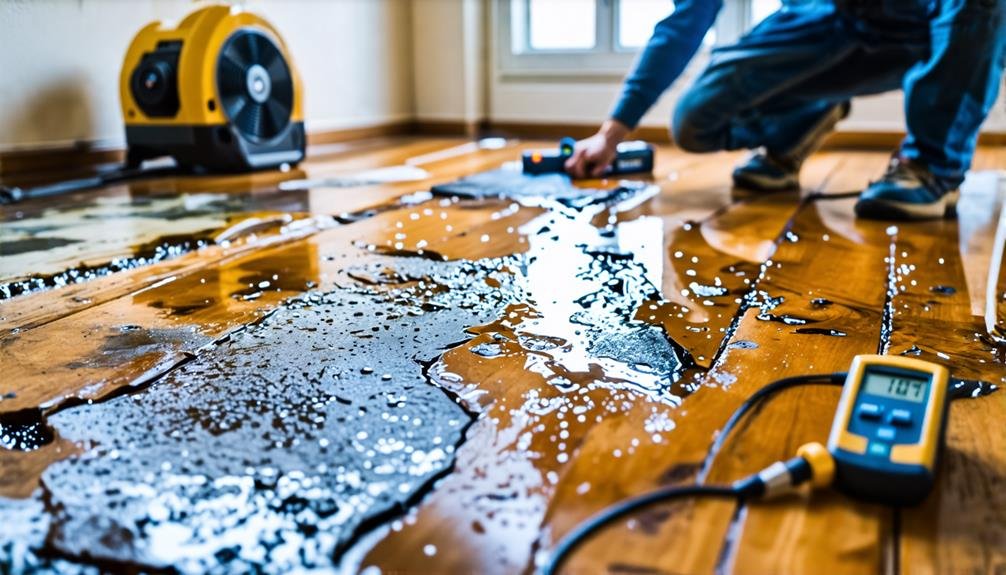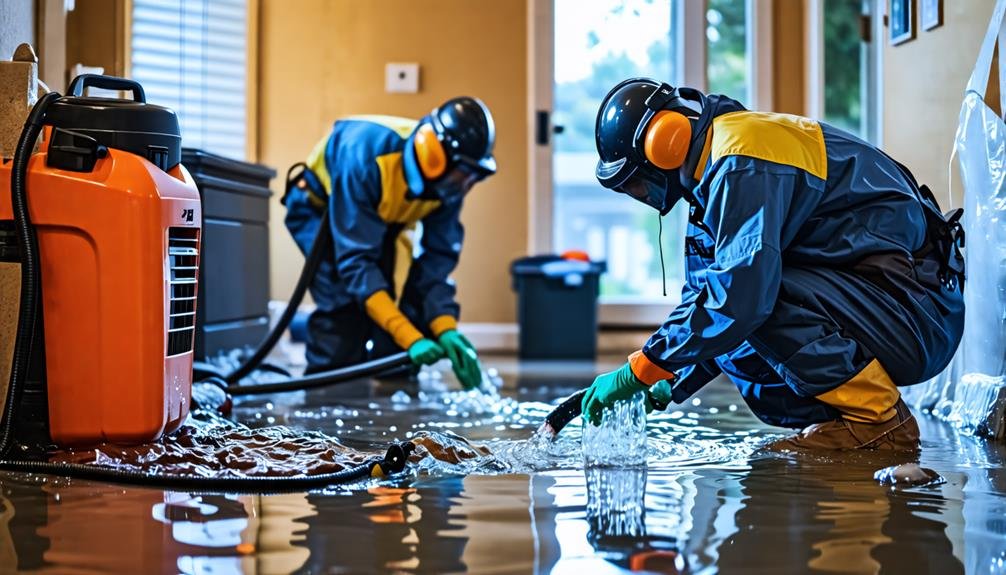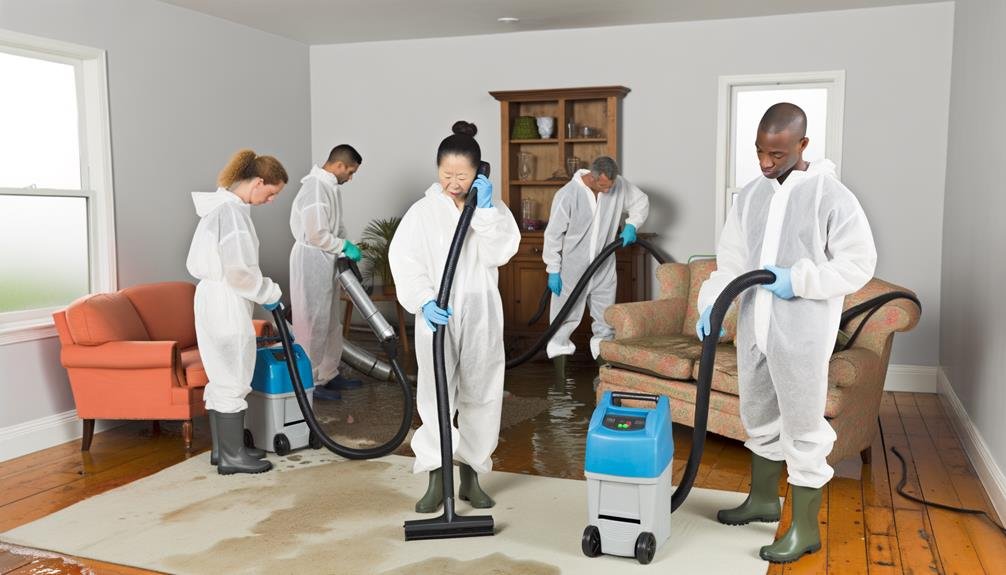When you face water damage in Fairburn, it's essential to act quickly. Professional services start with a thorough evaluation to determine the type of water—clean, gray, or black. Each type requires a tailored approach to restoration. After evaluating, technicians utilize specialized equipment for water extraction and drying, minimizing health risks and structural damage. They should communicate effectively throughout the process, ensuring your concerns are addressed and goals met. Choosing a certified provider improves reliability and efficiency. Understanding the complete process can help you make knowledgeable choices, paving the way for a healthier environment and safeguarding your investment in the long term.
Understanding Water Damage

When you encounter water damage, it's vital to recognize that the extent of the problem can vary considerably based on the source and duration of exposure. Understanding the different water types—clean, gray, and black—helps you assess the potential risks and necessary remediation measures. Clean water, often from broken pipes or rainwater, poses minimal health risks. Gray water, from appliances like dishwashers or washing machines, can contain contaminants, while black water, originating from sewage or floodwaters, can harbor dangerous pathogens.
Identifying damage sources is important for effective restoration. Common sources include plumbing failures, roof leaks, and natural disasters. Each source contributes uniquely to the damage severity and required intervention strategies. For instance, a slow leak from a pipe may lead to mold growth over time, while a sudden flood can cause immediate structural damage.
Signs of Water Damage
Recognizing the signs of water damage early can prevent further complications and costly repairs, allowing you to address issues before they escalate. Start by inspecting your home for visible signs like water stains on walls or ceilings. These often indicate leaky pipes, which can lead to more severe damage if left unchecked. Pay attention to any discoloration or peeling paint, as these are likewise red flags.
Next, check for musty odors, which may signal hidden mold growth. Mold thrives in damp environments, and its presence can compromise your health and property. Look for soft spots or warping in floors, particularly in areas near sinks or appliances, as these can suggest water intrusion.
Additionally, verify your windows and doors are sealed properly. Gaps or cracks can allow moisture to seep in, creating an environment favorable to water damage. Finally, monitor your water bills; an unexplained spike could indicate a hidden leak in your plumbing system. By being vigilant and addressing these signs promptly, you can safeguard your home from extensive water damage and maintain your freedom from unnecessary stress and expense.
The Restoration Process

Beginning the restoration process involves a thorough assessment of the water damage to determine the extent of the impact on your property. This initial evaluation is essential; it guides the entire restoration plan and incorporates effective restoration techniques tailored to your situation. Once the assessment is complete, the following steps are typically taken:
- Emergency response: Address any immediate hazards, such as electrical issues or structural instability, to guarantee safety.
- Water extraction: Utilize powerful pumps and vacuums to remove standing water, preventing further damage.
These steps are important in minimizing long-term damage and preventing mold growth. You'll want to stay involved throughout the process, making sure all actions align with your restoration goals. As you move forward, focus on clear communication with the restoration team, who will implement the necessary techniques to restore your property effectively. By understanding the restoration process, you empower yourself to make knowledgeable choices, ultimately leading to a more satisfying recovery experience.
Choosing a Professional Service
Selecting a professional water damage restoration service requires careful consideration of their experience, certifications, and customer reviews to guarantee they can effectively handle your specific situation. Start by verifying the company's certification standards. Look for certifications from recognized organizations like the Institute of Inspection, Cleaning and Restoration Certification (IICRC). These certifications indicate that the company adheres to industry best practices and possesses the necessary expertise.
Next, perform service comparisons among potential providers. Evaluate their scope of services, response times, and equipment quality. A reliable company should offer an extensive suite of services, including water extraction, structural drying, and mold remediation.
Don't forget to check customer reviews and testimonials. Authentic feedback from previous clients can give you valuable insights into their reliability and professionalism. Pay attention to how they handle claims with insurance companies, as this can greatly affect your overall experience.
Benefits of Timely Restoration

When you address water damage promptly, you greatly reduce the risk of structural issues that can compromise your property's integrity. Furthermore, timely restoration minimizes health hazards associated with mold and mildew growth. Prioritizing immediate action not only safeguards your home but likewise protects your family's well-being.
Prevents Structural Damage
Acting swiftly after water damage occurs can greatly reduce the risk of structural issues, ensuring your property remains safe and sound. When you delay restoration, water can compromise your building's foundation integrity, leading to costly repairs down the line. By addressing the problem promptly, you protect not just your immediate environment but likewise safeguard your long-term investment.
Here are some critical reasons to act quickly:
- Minimized Water Saturation: The longer water sits, the more it seeps into materials, weakening beams, drywall, and flooring.
- Reduced Repair Costs: Early intervention can greatly lower the financial burden related to extensive damage, including mold remediation and structural reinforcement.
Reduces Health Risks
Timely restoration of water damage greatly cuts down on the risk of health hazards, such as mold growth and airborne contaminants, which can arise from prolonged exposure to moisture. When water seeps into walls, ceilings, or flooring, it creates an ideal environment for mold spores to thrive. These spores can quickly multiply, leading to serious health issues, including respiratory problems and allergies.
By addressing water damage promptly, you greatly reduce the likelihood of mold growth. Professional restoration services employ advanced drying techniques and equipment, ensuring that any moisture is eliminated effectively. This not only helps in preventing mold but additionally improves air quality within your space.
Furthermore, stagnant water can introduce various contaminants into your environment. These contaminants can compromise your air quality, making it unsafe for you and your family. A thorough restoration process includes sanitizing affected areas, which removes harmful bacteria and allergens, ensuring a healthier living space.
In essence, acting swiftly during water damage events protects not just your property but also your well-being, allowing you to enjoy your home without the looming threat of health risks from mold and poor air quality.
Preventative Measures to Consider
To effectively prevent water damage, you need to implement regular maintenance checks throughout your property. Ensuring proper drainage systems and controlling moisture levels are crucial steps in safeguarding your home. By focusing on these critical measures, you can greatly reduce the risk of water-related issues.
Regular Maintenance Checks
Regular maintenance checks for your property can greatly reduce the risk of water damage by identifying potential leaks and vulnerabilities before they escalate into costly repairs. Implementing routine assessments and seasonal inspections should be a priority for any homeowner. These checks allow you to spot issues like wear and tear on pipes, roof damage, or drainage problems early on.
To guarantee thorough maintenance, consider the following:
- Inspect roofing and gutters: Regularly check for debris accumulation, loose shingles, or signs of leaks to prevent water from seeping into your home.
- Evaluate plumbing systems: Look for signs of corrosion, drips, or dampness around fixtures and pipes, addressing any issues promptly to avoid larger problems.
Proper Drainage Systems
Effective drainage systems are essential for preventing water accumulation around your property, ensuring that excess rainwater is directed away from foundations and vulnerable areas. To achieve this, you'll want to investigate various drainage solutions tailored to your environment's specific needs. Start by evaluating your current setup, including gutters and downspouts, to confirm they're functioning properly and directing water away from your home.
Terrain grading is another important aspect of effective drainage. By sloping the ground away from your foundation, you can greatly reduce the risk of water pooling near your property. Ideally, the grade should slope down at least six inches over the first ten feet.
Additionally, consider installing French drains or surface drains in low-lying areas. These systems allow excess water to flow away efficiently, minimizing the risk of water damage. Regularly inspect and clear debris from all drainage systems to maintain peak performance.
Effective Moisture Control
Implementing effective moisture control measures is vital to complementing your drainage systems, as it directly impacts the prevention of water damage inside your home. To guard against excess moisture, you'll need to take into account a combination of humidity control and physical barriers designed to keep water at bay. Here are a few key strategies:
- Install Moisture Barriers: Use vapor barriers in crawl spaces and basements to prevent ground moisture from seeping into your living areas. These barriers are critical in maintaining a dry environment and reducing humidity levels.
- Use Dehumidifiers: In areas prone to high humidity, dehumidifiers can effectively regulate moisture levels. Make sure you regularly empty the tanks and maintain the units for peak performance.
Conclusion
In the end, you might think ignoring water damage is a harmless choice, but that couldn't be further from the truth. Procrastination only amplifies the issue, leading to costly repairs and health hazards. By investing in professional restoration services, you're not just fixing a problem; you're safeguarding your home and peace of mind. It's ironic how a small leak can teach you the importance of vigilance and prompt action. Don't let a drip turn into a disaster—act decisively.

